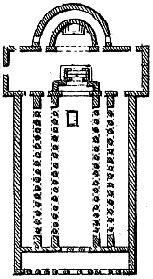| |

Plan of the Basilica of St. John Lateran at Rome; this monument of the fourth century, with the accessary buildings by which it is surrounded, form an ensemble the most imposing. The church was at first called Basilica Constantinina, or Basilica Aurea. Constructed after the model of the ancient Roman basilicas, it offered at the same time all the parts necessary for the liturgy of the primitive church; the apsis or tribune, in the center of which was the papal chair; the Confession and beyond the altar where the Pope alone celebrated the holy mysteries, was the presbytery for the clergy, ambons for the reading of the epistle and gospel, and a vestiary for the ecclesiastical hierarchy.
Without and around the basilica were various chapels and oratories, and amongst other sacred buildings the baptistery, still preserved and still brilliant with the marbles and precious metals with which it was adomed by the fervour of Constantine. Until the period of the introduction of conclaves, the election of the sovereign pontiff took place in this church, and it is still here that they come after their election to take solemn possession of the pontificate in presence of the clergy and the Roman people.
At all times, amongst all people, ancient or modern, in Egypt, in India, in Mexico, the principal places for religious worship have always been and still are accompanied by accessories necessary for its exercise or to augment its splendor; it was the same with this basilica, called Sacro-Sancta, et de omnium urbis et orbis ecclesiarum mater et caput. In a vast enclosure were united, under the name of Patriarchum Lateranense, all the accessary buildings necessary for the residence of an ecclesiastical prince--private oratories, libraries, halls of council, others more vast for holding synods and the meeting of councils, triclinia or dining-halls destined for the agape or sacred repasts, and an elevated tribune from which the pope blessed the faithful. Under the porticos were assembled the penitent, and the travelers attracted by their devotion for the holy places; in the triclinia, instead of the sumptuosity of the pagan festivals, reigned the frugality of the holy repasts, the austerity of the fasts of the religious orders, and regular priests there formed the cortege of the pope in the place of the pretorian guard, whose lodgments were converted into monasteries and cloistered houses which still subsist. Gardens of the useful rather than the luxurious furnished the subsistence of these ecclesiastics, and distributed health in their habitations; in fact, as the cathedral of the Christian world, and the palace of the pope, the Temple of St. John Lateran, traced by the hand of Constantine himself (ejus aream, propriis manibus sarculo admotis, ipse descripsit), augmented, embellished, and restored by a number of emperors and Popes, serving successively as the place of election and habitation for some, and the coronation of others, has always been one of the most imposing monuments which architecture has ever raised in honour of God, and the men specially dedicated to his worship. Ciampini in his treatise De sacris oedificiis a Constantino magno constructis, gives at chap. ii, pl. iii, the general plan of this basilica with all its dependencies, in the state in which they were before a part was demolished to make way for the majestic palace erected by Sixtus V.
Seroux
| |
|